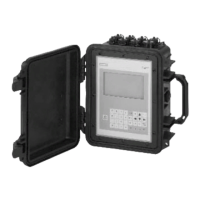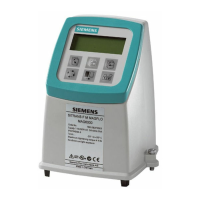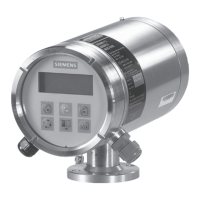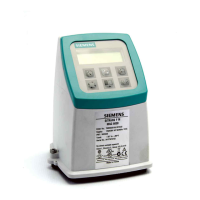Troubleshooting
10.3 Test Facilities Graph Screen
FUE1010 IP65 NEMA 4X
Operating Instructions, 12/2014, A5E03086491-AC
153
The text to the upper left-hand corner of the screen represents diagnostic items which can
be individually turned on or off to reduce unnecessary clutter on the screen. This text display
can be modified by pressing the <ENTER> key and scrolling up or down through the various
parameters that appear in the Graph Display menu. Pressing the <ENTER> key will select
the highlighted parameter (a "+" sign appears next to selected items) and pressing <CLR>
will deselect the item. Pressing the <Left Arrow> will return you to the graph screen with the
selected parameters appearing at the top left corner of the screen. (The sample graph above
is shown with all diagnostics items selected).
Table 10- 2 Description of Graph Screen Text Display Parameters
F Flow Measured flow rate in selected flow
VS Vs m/s Sound Velocity in meters per second.
[ ] Display Metrics Represents the digital sample position
Correlated plot Displays the receive waveform in its
proper superposition or registration.
The true delta time will be displayed by
NOT selecting "Correlated Plot".
Centroid Mark Indicates with a large vertical marker
the peak energy of the receive wave-
D Damping Displays the minimum and maximum
digital damping exponent along with the
active damping exponent.
Tn Tn (usec) Receive signal transit time in microsec-
dT DeltaT (nsecs) Transit time delta (difference) in nano-
S Signal Strength Displays %Valc (amplitude), %Vaer
(aeration factor) and numeric ALC.
SN Signal-to-Noise Ratio Indicates the signal to noise ratio of the
receive signal. Increased damping will
increase the S/N ratio as the asynchro-
Envelope Percentage change of the signal from
Initial Makeup conditions.
The digitized receive signal can be moved either to the left or right on the screen by pressing
the <Left> or <Right> keypad arrows. The direction of the arrow actually represents the
direction in which the Receive "window" will move, thereby causing the receive signal to shift
in the opposite direction on the screen (e.g., Pressing the <Left Arrow> moves the signal to
the right).

